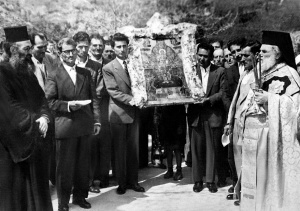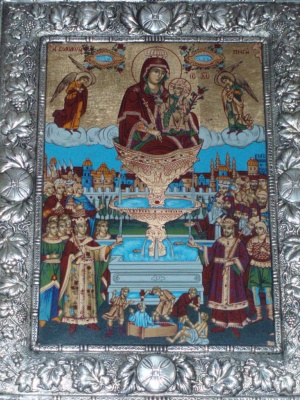Difference between revisions of "Life-Giving Spring"
m |
m |
||
| Line 7: | Line 7: | ||
==Revelation of the Life-Giving Spring== | ==Revelation of the Life-Giving Spring== | ||
[[Image:Saint Mary Of The Spring.jpg|right|thumb|The [[w:Holy well|Holy well]] (Hagiasma) of the Church of the Life Giving Font (Istanbul).]] | [[Image:Saint Mary Of The Spring.jpg|right|thumb|The [[w:Holy well|Holy well]] (Hagiasma) of the Church of the Life Giving Font (Istanbul).]] | ||
| − | [[Image:Procession-Feast of Zoodohos Pigi-Arcadia,Greece-1950s.jpg|thumb|right|Procession on the [[feast day]] of | + | [[Image:Procession-Feast of Zoodohos Pigi-Arcadia,Greece-1950s.jpg|thumb|right|Procession on the [[feast day]] of the Life-giving Spring, [[w:Bright Friday|Bright Friday]] 1959, [[w:Arcadia|Arcadia]], Greece.]] |
There are two accounts extant concerning the revelation of the Life-Giving Font. It is likely in either case, that before the 5th-6th century monastery was erected, a shrine with a spring of water by a grove of trees dedicated to the [[Theotokos]], had already existed outside the City of Constantinople from early times. Over time, the grove had became overgrown and the spring had become fetid.<ref>Archpriest Feodor S. Kovalchuk. ''Wonder-Working Icons of the Theotokos.'' Youngstown OH: Central Satates Deanery, 1985. pp.67–70.</ref><br> | There are two accounts extant concerning the revelation of the Life-Giving Font. It is likely in either case, that before the 5th-6th century monastery was erected, a shrine with a spring of water by a grove of trees dedicated to the [[Theotokos]], had already existed outside the City of Constantinople from early times. Over time, the grove had became overgrown and the spring had become fetid.<ref>Archpriest Feodor S. Kovalchuk. ''Wonder-Working Icons of the Theotokos.'' Youngstown OH: Central Satates Deanery, 1985. pp.67–70.</ref><br> | ||
Revision as of 17:41, May 14, 2011
- This article is about the feast day of the Life-Giving Spring. For the historic monastery see Church of the Life-Giving Font of the Theotokos (Istanbul).
The Life-Giving Spring or Life-Giving Font of the Mother of God (in Greek: Ζωοδόχος Πηγή) is both the feast day of a historic church just west of Constantinople in Valoukli, and an icon of the Theotokos.
The feast day of the Life-Giving Spring is commemorated on Bright Friday of each year (the Friday following Pascha), being the only feast day which may be celebrated during Bright Week. The Life-Giving Spring Icon of the Most Holy Theotokos is commemorated by the Orthodox Church on April 4.
Contents
Revelation of the Life-Giving Spring

There are two accounts extant concerning the revelation of the Life-Giving Font. It is likely in either case, that before the 5th-6th century monastery was erected, a shrine with a spring of water by a grove of trees dedicated to the Theotokos, had already existed outside the City of Constantinople from early times. Over time, the grove had became overgrown and the spring had become fetid.[1]
Nicephorus Callistus
The traditional account is recorded by Nikephoros Kallistos Xanthopoulos, the last of the Greek ecclesiastical historians, who flourished around 1320. This tradition begins with a miracle that occurred involving a soldier named Leo Marcellus, who would later become the Byzantine Emperor Leo I the Thracian (457-474). While Leo was on his way to Constantinople he encountered a blind man near the Golden Gate who was thirsty. Though he agreed to search for water, he was unable to find any. A female voice was then heard who told the future Emperor that there was water nearby. Looking about, he could see no one, and neither could he see any water. Then he heard the voice again:
- "Emperor Leo, go into the deepest part of the woods, and you will find water there. Take some of the cloudy water in your hands and give it to the blind man to drink. Then take the clay and put it on his eyes. Then you shall know who I am."[2]
The same voice added that she had chosen that very place to be worshiped and prophesied that he would one day receive the crown to the empire. Leo followed her order and at once the blind man recovered his eyesight. After his accession to the throne, the Emperor erected a magnificent church on this place, and the water continued to work miraculous cures. Therefore, it was called "The Life-Giving Spring."
Procopius
A second account is given by the prominent Byzantine scholar Procopius of Caesarea (flourishing ca.500-565).[note 1] In this version, the Emperor Justinian was out hunting when he came upon a small chapel in a beautiful wooded area, surrounded by a large crowd of people and a priest in front of a spring. Inquiring about this site, he was told that this was the “source of miracles”. He at once ordered that a magnificent church be built there, utilizing materials that had remained after the erection of the Hagia Sophia.[3] The church was erected in the last years of his reign, ca.559-560, near the holy spring.[note 2] After the erection of the sanctuary, the Gate that was situated outside the walls of Theodosius II was named by the Byzantines Gate of the Spring (Greek: Πύλη τῆς Πηγῆς).[4]
The Icon
The icon representing the Virgin of the Spring shows the Virgin blessing and embracing the Child. She is surrounded by two angels, and is sitting on the more elevated of two basins, presumably representing the "living water" which is Christ.[note 3] The living water from the more elevated basin flows into a larger marble basin below, which is in the shape of a cross.[note 4]
In one modern Greek version of the icon that was found on Naxos island, Greece,[note 5] some differences are shown with respect to the ancient type. Around the cross-shaped basin stands the Emperor with his guard, while on the right there is the Patriarch with his bishops. In the background, is represented Leo I with the blind man, together with the walls of the City. Under the basin a paralytic and a madman are healed with the spring’s water.
Hymn
In Orthodox hymnography, the Theotokos is frequently compared with a Holy Fountain. The hymns and prayers of the feast are combined with the Paschal hymns, and there is often a Lesser Blessing of Waters performed after the Divine Liturgy on Bright Friday.
Apolytikion in the Third Tone[5]
- As a life-giving fount, thou didst conceive the Dew that is transcendent in essence,
- O Virgin Maid, and thou hast welled forth for our sakes the nectar of joy eternal,
- which doth pour forth from thy fount with the water that springeth up
- unto everlasting life in unending and mighty streams;
- wherein, taking delight, we all cry out:
- Rejoice, O thou Spring of life for all men.
- O most favored by God,
- You confer on me the healing of your grace from your inexhaustible Spring.
- Therefore, since you gave birth incomprehensibly to the Word,
- I implore you to refresh me with the dew of your grace that I might cry to you:
- Hail, O Water of salvation.
See also
Notes
- ↑ The 11th century Byzantine historian George Cedrenus also mentions this version.
- ↑ In this context, "Holy Spring/Holy Font/Holy Source" becomes synonymous with the Greek: ἁγίασμα, hagiasma; Lit.: 'sanctuary'.
- ↑ This living water is contained in the Cross which must be born by all those who follow Him, just as He did.
- ↑ In the early Church, the baptismal font was actually in the form of a cross, just like the cross depicted in this icon. Christians would enter from the base of the cross and come out at the top, and then re-enter from the left of the cross and come out on the right of the cross; then the priest, who would be standing in the middle of the cross/baptismal font, would commune them.
- ↑ Icon of "Panagia Argokiliotissa", from Naxos island, Greece (Greek: Παναγία η Αργοκοιλιώτισσα - Νάξος).
References
- ↑ Archpriest Feodor S. Kovalchuk. Wonder-Working Icons of the Theotokos. Youngstown OH: Central Satates Deanery, 1985. pp.67–70.
- ↑ 2.0 2.1 OCA - Feasts and Saints. Bright Friday. The Life Giving Spring of the Mother of God.
- ↑ Raymond Janin (in French). La Géographie ecclésiastique de l'Empire byzantin. 1. Part: Le Siège de Constantinople et le Patriarcat Oecuménique. 3rd Vol.: Les Églises et les Monastères. Paris: Institut Français d'Etudes Byzantines. 1953. p.232-37.
- ↑ Wolfgang Müller-Wiener (in German). Bildlexikon zur Topographie Istanbuls: Byzantion, Konstantinupolis, Istanbul bis zum Beginn d. 17 Jh.. Tübingen: Wasmuth, 1977. pp.416.
- ↑ 5.0 5.1 Greek Orthodox Archdiocese of America. Renewal Friday: Theotokos of the Lifegiving Font.
External links
Wikipedia
Other
- The Miracle of The Veil in Constantinople 911 AD.
- Question 5. "What feast is celebrated Bright Friday?", St Nicholas Russian Orthodox Church, Dallas Texas.
Greek Wikipedia
Categories > Arts
Categories > Arts
Categories > Church Life > Theotokonymia
Categories > Church Life > Theotokonymia > Icons of the Theotokos
Categories > Images > Icons
Categories > Liturgics > About Icons
Categories > Liturgics > About Icons
Categories > Liturgics > Feasts
Categories > Liturgics > Feasts
Categories > Liturgics > Feasts


